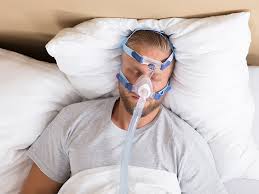
Continuous positive airway pressure (CPAP) refers to a form of positive airway pressure (PAP) ventilation in which a constant level of pressure above atmospheric pressure is continuously applied to the upper airway.
CPAP therapy uses machines deliver a flow of air at a constant pressure.
The constant stream of air opens and keeps the upper airway unobstructed during inhalation and exhalation.
Continuous positive airway pressure (CPAP), applies a single level of positive airway pressure throughout the whole respiratory cycle.
CPAP may be intended to prevent upper airway collapse, as occurs in obstructive sleep apnea, or to reduce the work of breathing in conditions such as acute decompensated heart failure.
It is highly effective for managing obstructive sleep apnea.
Compliance and acceptance of its use can be a limiting factor: 8% of people stopping use after the first night and 50% within the first year.
It is 100% effective at eliminating obstructive sleep apneas in the majority of people who use the therapy according to recommendations.
CPAP can be used to treat pre-term infants whose lungs have not yet fully developed, in infants with respiratory distress syndrome, and it is associated with a decrease in the incidence of bronchopulmonary dysplasia.
In preterm infants whose lungs have not fully developed, CPAP may improve survival and decreases the need for steroid treatment for their lungs.
CPAP is not useful for:
A person is not breathing on their own
A person is uncooperative or anxious
A person cannot protect their own airway
A person is not stable due to respiratory arrest
A person has experienced facial trauma or facial burns
Previous facial, esophageal, or gastric surgeries.
Associated problems with CPAP:
Generalized discomfort,
Nasal congestion,
Bloating,
Claustrophobia,
Mask leaking
Some CPAP machines have heated humidifiers.
It is an alternative to ((positive end-expiratory pressure)) (PEEP).
CPAP and PEEP stent the lungs’ alveoli open and thus recruit more of the lung’s surface area for ventilation, but, while PEEP refers to devices that impose positive pressure only at the end of the exhalation, CPAP devices apply continuous positive airway pressure throughout the breathing cycle.
The ventilator itself does not cycle during CPAP, no additional pressure above the level of CPAP is provided, and patients must initiate all of their breaths.
Nasal prongs or nasal mask is the most common modality of treatment.
Nasal CPAP is frequently used in infants, though its use is controversial.
Nasal CPAP reduces ventilator time but an increased occurrence of pneumothorax.
Nasopharyngeal CPAP is administered by a tube that is placed through the person’s nose and ends in the nasopharynx.
Oral masks and naso-oral masks are often used when nasal congestion or obstruction is a complaint.
Over 50% of people discontinue CPAP use in the first year.
Changes in behaviour is required to commit to long-term use of CPAP therapy.
Many with moderate to severe obstructive sleep apnea have a higher risk of symptoms such as anxiety and depression, making it more difficult to use CPAP on a regular basis.
Adherence to CPAP is associated with reduced major adverse cardio/cerebral events.
